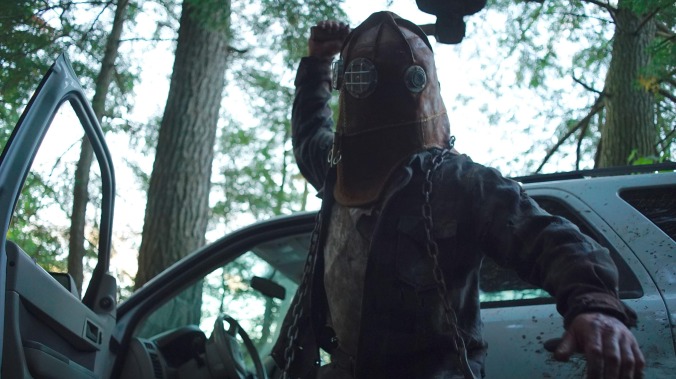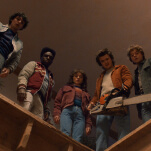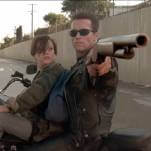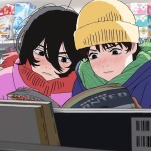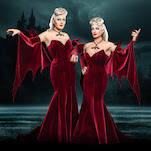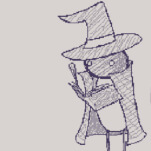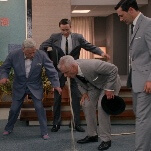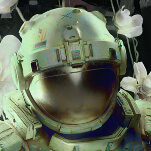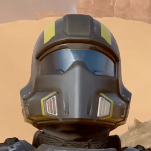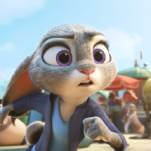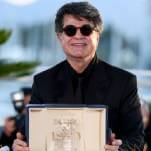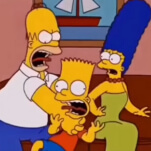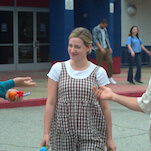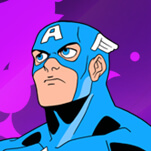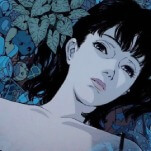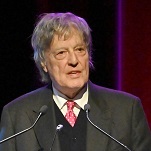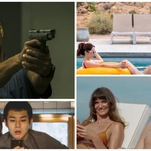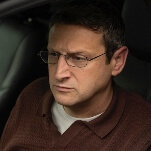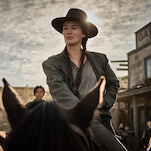It’s dedicated and confident, which makes for a movie that’s almost serene. That means that the over-the-top deaths are all the more fun, perfectly calibrated to make you jump, gag, scream, and laugh all at once. And it’s kind of a miracle that it turned out this well. The movie went through extensive reshoots after an initial edit just didn’t feel right. Without having seen that earlier footage, it seems like it was the right move, because In A Violent Nature just feels right.
CN: One of the main things you strive for when you’re doing any kind of character creation is, “What does the silhouette look like?” How impressive is it? When you’re dealing with somebody that’s more of a humanoid slasher than a monster, every small detail matters. The collar being torn and tattered, how does that show up? Everything that can lean into the uncanny a little bit more, to make an audience feel unsafe. And then how that silhouette moves is integral. Anton Chigurh’s movements through a scene are so distinctive. Johnny’s movements, and what Ry Barrett gave to the character, really draw you in. Really makes you feel uncertain, even though you know what’s going to happen.
AVC: It’s really hard to impress when you’re “the monster” of the horror movie, but the heaviness he’s able to bring…you feel every step. I know Barrett wasn’t originally your Johnny, and when you were piecing together footage of old Johnny and new Johnny, trying to see if you could make them interchangeable, the gait was different. The vibe was off. Can you talk about what struck you about the latter performance compared to the former?
CN: It’s really hard to judge the previous performance, because I look at them as such distinct, individual takes on the character. The first performer that we had playing Johnny for the majority of the first half of principal photography—because we did shoot principal photography for four weeks, shooting roughly 75% or 80% of the film that we essentially scrapped all but six seconds of—had to leave for medical issues. Then for the last two weeks, we had another performer come on. And that’s when we spotted all the differences.
So I look at that whole section as one Johnny performance, even though it’s two actors. Each one brought their own thing, had their own entry point into it. The first actor we had was definitely much softer. Almost inquisitive of the surroundings—almost like a newborn fawn, just exploring. The second actor was way more menacing, way more brooding. Also, much more muscular, especially in the shoulders. That was a jarring back-and-forth to cut between.
Ry, his performance is hyper-objective. He can’t be bothered with anything that’s happening in the scene. He’s just got a job to do and the sooner he does it, the sooner he can get off work. That in itself brings a threat that wasn’t there before. In line with the Anton Chigurh comparison, it’s that objectivity—there is no reasoning. That’s a hard thing to do when you’re just walking and turning your body.
AVC: I love that there was a take on this character that was like a newborn fawn. That’s such a different facet to the idea of “force of nature.” The inevitability, though, brings the right atmosphere, maybe more than anything that had more personality or humanization.
CN: I realized that in comparison with our first block of shooting. I was just a little too close. The filmmaking was just a little too close. We were a little too beside the character rather than behind the character.
AVC: Oh, you mean literally close.
CN: Literally close! But it does the psychological trick too, where we feel much more intimate with who Johnny is. Watching that, it was clear it was not the way to go. We had to do a few things to be more removed from him.
AVC: You also switched up cinematographers between production blocks. How did your team achieve the movie’s floaty, not quite disconnected yet not quite on rails tracking shot?
CN: The cinematographer who ended up shooting the majority of what everybody sees, Pierce Derks, was originally the second unit and [behind-the-scenes] cinematographer on our first block. When he took over from Andrew Appelle, who was unable to return due to other commitments, that was another lesson we took from the whole first experience. We had a completely different camera rig that took up a much larger footprint, and it caused issues even just going through the woods. We’re following our character, but we’re almost five feet wide and eight feet tall. We have to literally carve out trails so we’re not getting smacked around by sticks while we’re trying to follow him.
Pierce found a kind of Steadicam/Glidecam hybrid that he cobbled together with different parts, and he was cobbling new parts onto it up until the very end. It provided a system that was much more lightweight and much more easy to handle for just one person. It also took up a much smaller space, so he could follow Johnny and there wasn’t too much weight on him. We didn’t have to carve out huge trails. We could let foreground elements and sticks almost swat up against the camera. It definitely changed the whole feel of the film, being able to tear down and get smaller.
AVC: It’d be really obvious that this guy was walking through a place cleared out for something not quite his size. In the film, you’re squished between trees. You feel lost. Can you talk about what you wanted to pull out of the woods in Northern Ontario?
CN: There’s the nostalgia factor. It’s where I grew up, and I did have an image of what I wanted it to be. But because it plays into the mythology of the character, with all the logging equipment, we needed to see those towering forests to tie into it. In our original block of shooting, we weren’t shooting in Northern Ontario. It was much closer to Toronto, where a lot of the crew was located. But traveling through oak trees and cedar trees, they’ve got their own aesthetic. They exude something completely different than towering pines and evergreens. It seemed very trivial but it became incredibly important. The woods had to be perfect.
In its inception, this seemed like this would be such an easy movie to make. [Laughs.] We just follow somebody through the woods. Then you realize that nothing is easy, that there are all these technical issues just trying to get that shot, walking through the woods. And then you realize that the woods themselves matter, that the trees that you point at matter so much when they’re the other character in the film.
AVC: That probably came up a lot, where you’re going back and saying, “This is my baby, this is my debut. Do I really want to compromise on anything, or should I risk it all because this is what I saw in my head?”
CN: There’s the adage that perfect is the enemy of good. That was playing through my head the entire time. Is this worth fighting for? Is this an issue that needs to be addressed or am I just nitpicking everything? That’s a hard thing to figure out, and I think it’ll be one of those things that’s difficult to parse forever.
AVC: Last question. I’ve read about your influences, ranging from Terrence Malick to Gus Van Sant, but I had to ask: Are you a video game person at all?
CN: No! I’m an admirer of video games. I was at exactly the wrong age when the Super Nintendo moved on to the Nintendo 64. I wasn’t an early N64 adapter. The joystick controls were too much. All of a sudden, we’re in manual cars instead of automatics. I was like, “Why are we doing this?”
AVC: The moment the film switches from an over-the-shoulder to a top-down view, I thought, “This is a gamer.” But I guess you just had the vision.
CN: Well, I mean, I watch them. I watch a lot of Let’s Plays. So I’m familiar, but I’m the kid on the bench while everyone’s playing baseball. [Laughs.] It was all my Smash TV experience coming to play.
